Substance Use & Society
VerifiedAdded on 2022/12/29
|15
|5169
|57
AI Summary
This essay explores the statement that drugs have been used for centuries and how they have been redefined in social, cultural, political, and economic contexts. It discusses drug trends and meanings within a sociocultural context.
Contribute Materials
Your contribution can guide someone’s learning journey. Share your
documents today.
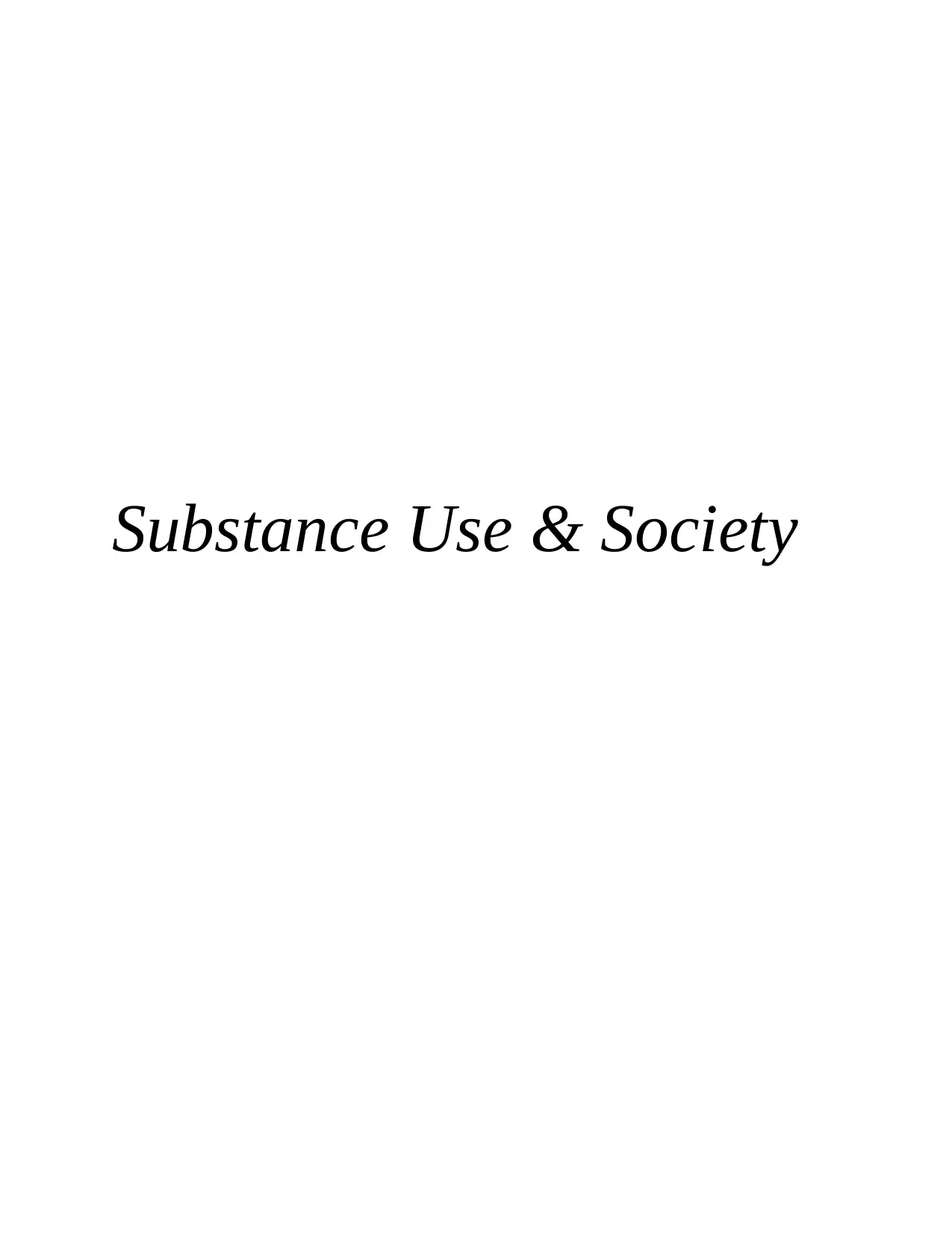
Substance Use & Society
Secure Best Marks with AI Grader
Need help grading? Try our AI Grader for instant feedback on your assignments.
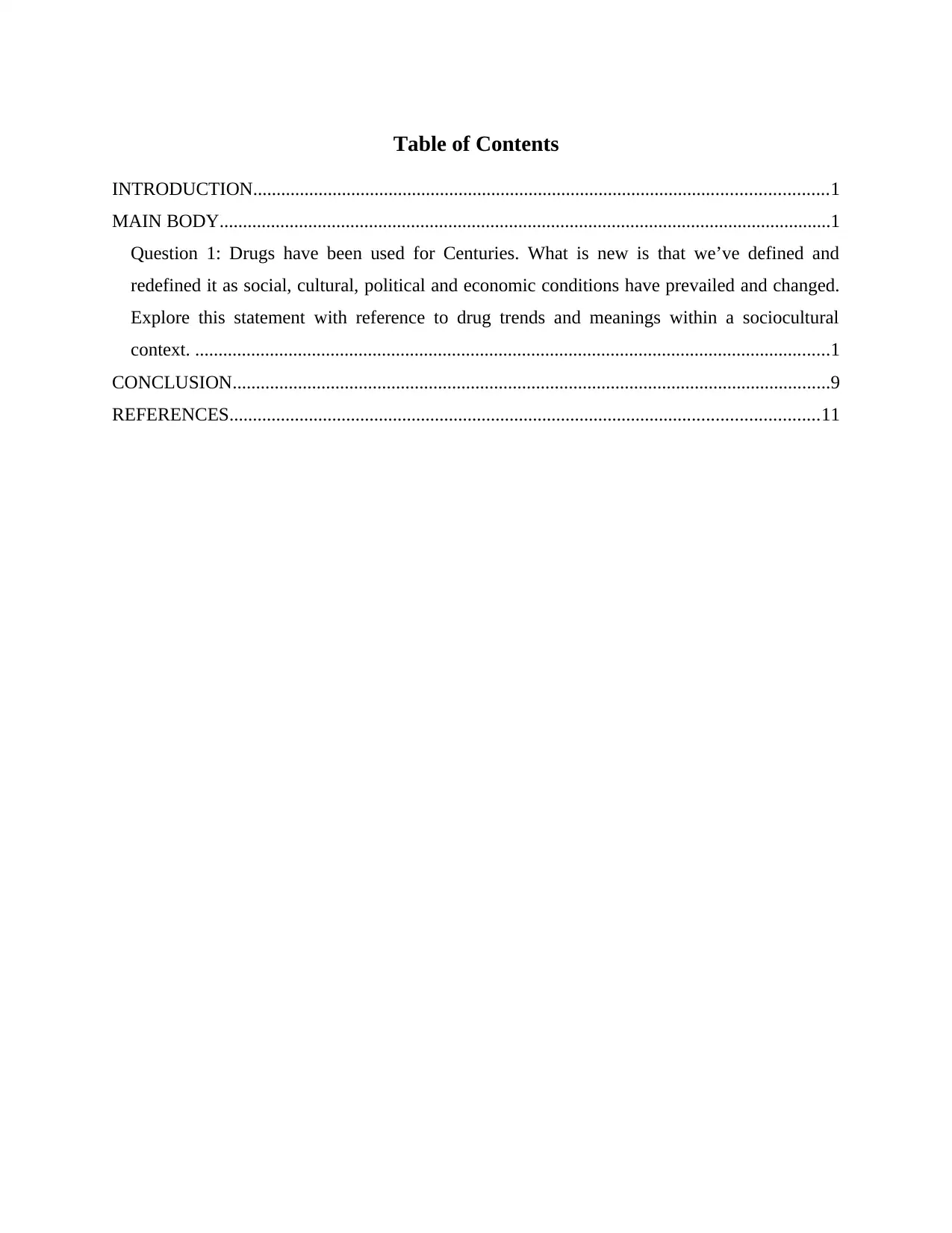
Table of Contents
INTRODUCTION...........................................................................................................................1
MAIN BODY...................................................................................................................................1
Question 1: Drugs have been used for Centuries. What is new is that we’ve defined and
redefined it as social, cultural, political and economic conditions have prevailed and changed.
Explore this statement with reference to drug trends and meanings within a sociocultural
context. ........................................................................................................................................1
CONCLUSION................................................................................................................................9
REFERENCES..............................................................................................................................11
INTRODUCTION...........................................................................................................................1
MAIN BODY...................................................................................................................................1
Question 1: Drugs have been used for Centuries. What is new is that we’ve defined and
redefined it as social, cultural, political and economic conditions have prevailed and changed.
Explore this statement with reference to drug trends and meanings within a sociocultural
context. ........................................................................................................................................1
CONCLUSION................................................................................................................................9
REFERENCES..............................................................................................................................11

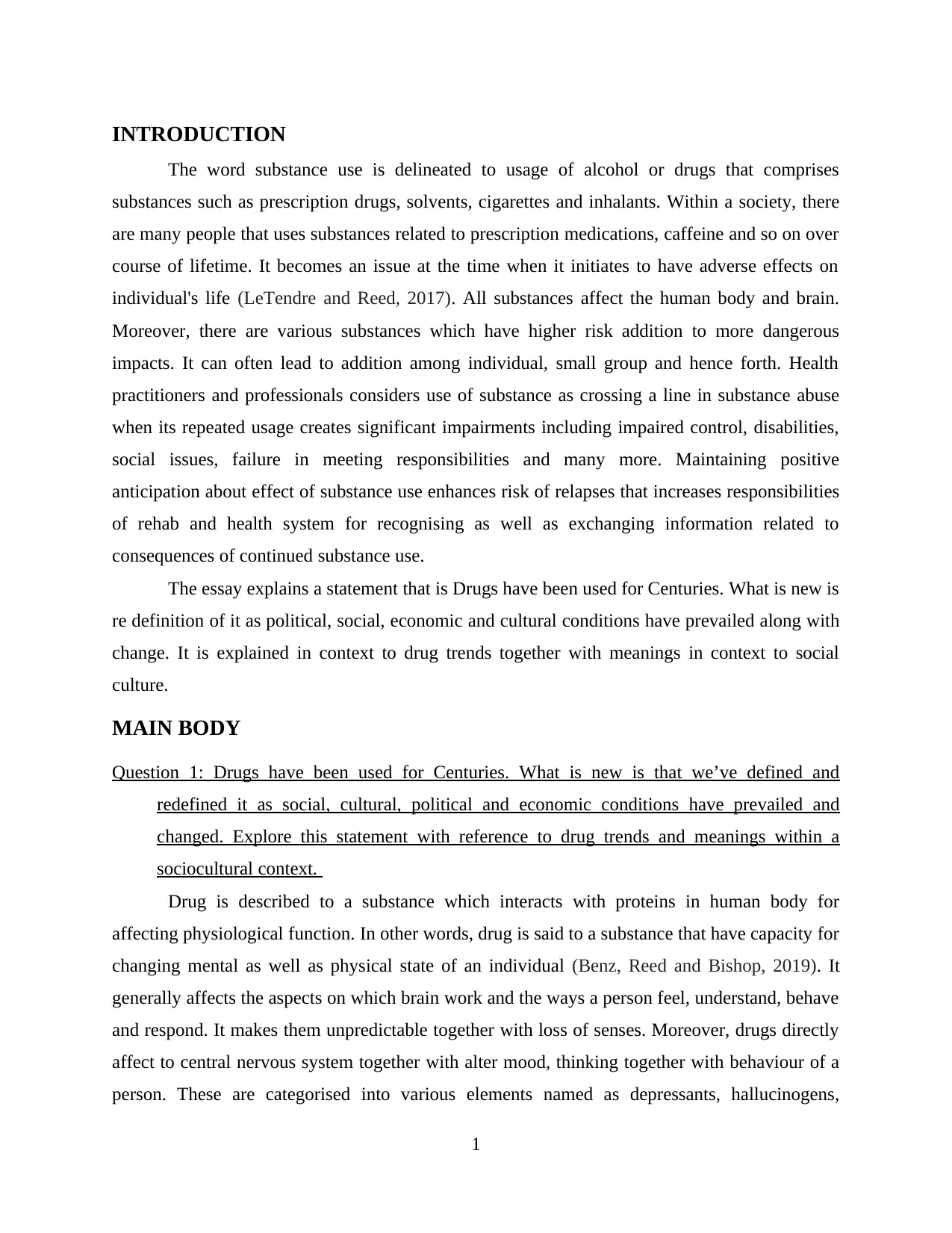
INTRODUCTION
The word substance use is delineated to usage of alcohol or drugs that comprises
substances such as prescription drugs, solvents, cigarettes and inhalants. Within a society, there
are many people that uses substances related to prescription medications, caffeine and so on over
course of lifetime. It becomes an issue at the time when it initiates to have adverse effects on
individual's life (LeTendre and Reed, 2017). All substances affect the human body and brain.
Moreover, there are various substances which have higher risk addition to more dangerous
impacts. It can often lead to addition among individual, small group and hence forth. Health
practitioners and professionals considers use of substance as crossing a line in substance abuse
when its repeated usage creates significant impairments including impaired control, disabilities,
social issues, failure in meeting responsibilities and many more. Maintaining positive
anticipation about effect of substance use enhances risk of relapses that increases responsibilities
of rehab and health system for recognising as well as exchanging information related to
consequences of continued substance use.
The essay explains a statement that is Drugs have been used for Centuries. What is new is
re definition of it as political, social, economic and cultural conditions have prevailed along with
change. It is explained in context to drug trends together with meanings in context to social
culture.
MAIN BODY
Question 1: Drugs have been used for Centuries. What is new is that we’ve defined and
redefined it as social, cultural, political and economic conditions have prevailed and
changed. Explore this statement with reference to drug trends and meanings within a
sociocultural context.
Drug is described to a substance which interacts with proteins in human body for
affecting physiological function. In other words, drug is said to a substance that have capacity for
changing mental as well as physical state of an individual (Benz, Reed and Bishop, 2019). It
generally affects the aspects on which brain work and the ways a person feel, understand, behave
and respond. It makes them unpredictable together with loss of senses. Moreover, drugs directly
affect to central nervous system together with alter mood, thinking together with behaviour of a
person. These are categorised into various elements named as depressants, hallucinogens,
1
The word substance use is delineated to usage of alcohol or drugs that comprises
substances such as prescription drugs, solvents, cigarettes and inhalants. Within a society, there
are many people that uses substances related to prescription medications, caffeine and so on over
course of lifetime. It becomes an issue at the time when it initiates to have adverse effects on
individual's life (LeTendre and Reed, 2017). All substances affect the human body and brain.
Moreover, there are various substances which have higher risk addition to more dangerous
impacts. It can often lead to addition among individual, small group and hence forth. Health
practitioners and professionals considers use of substance as crossing a line in substance abuse
when its repeated usage creates significant impairments including impaired control, disabilities,
social issues, failure in meeting responsibilities and many more. Maintaining positive
anticipation about effect of substance use enhances risk of relapses that increases responsibilities
of rehab and health system for recognising as well as exchanging information related to
consequences of continued substance use.
The essay explains a statement that is Drugs have been used for Centuries. What is new is
re definition of it as political, social, economic and cultural conditions have prevailed along with
change. It is explained in context to drug trends together with meanings in context to social
culture.
MAIN BODY
Question 1: Drugs have been used for Centuries. What is new is that we’ve defined and
redefined it as social, cultural, political and economic conditions have prevailed and
changed. Explore this statement with reference to drug trends and meanings within a
sociocultural context.
Drug is described to a substance which interacts with proteins in human body for
affecting physiological function. In other words, drug is said to a substance that have capacity for
changing mental as well as physical state of an individual (Benz, Reed and Bishop, 2019). It
generally affects the aspects on which brain work and the ways a person feel, understand, behave
and respond. It makes them unpredictable together with loss of senses. Moreover, drugs directly
affect to central nervous system together with alter mood, thinking together with behaviour of a
person. These are categorised into various elements named as depressants, hallucinogens,
1
Secure Best Marks with AI Grader
Need help grading? Try our AI Grader for instant feedback on your assignments.
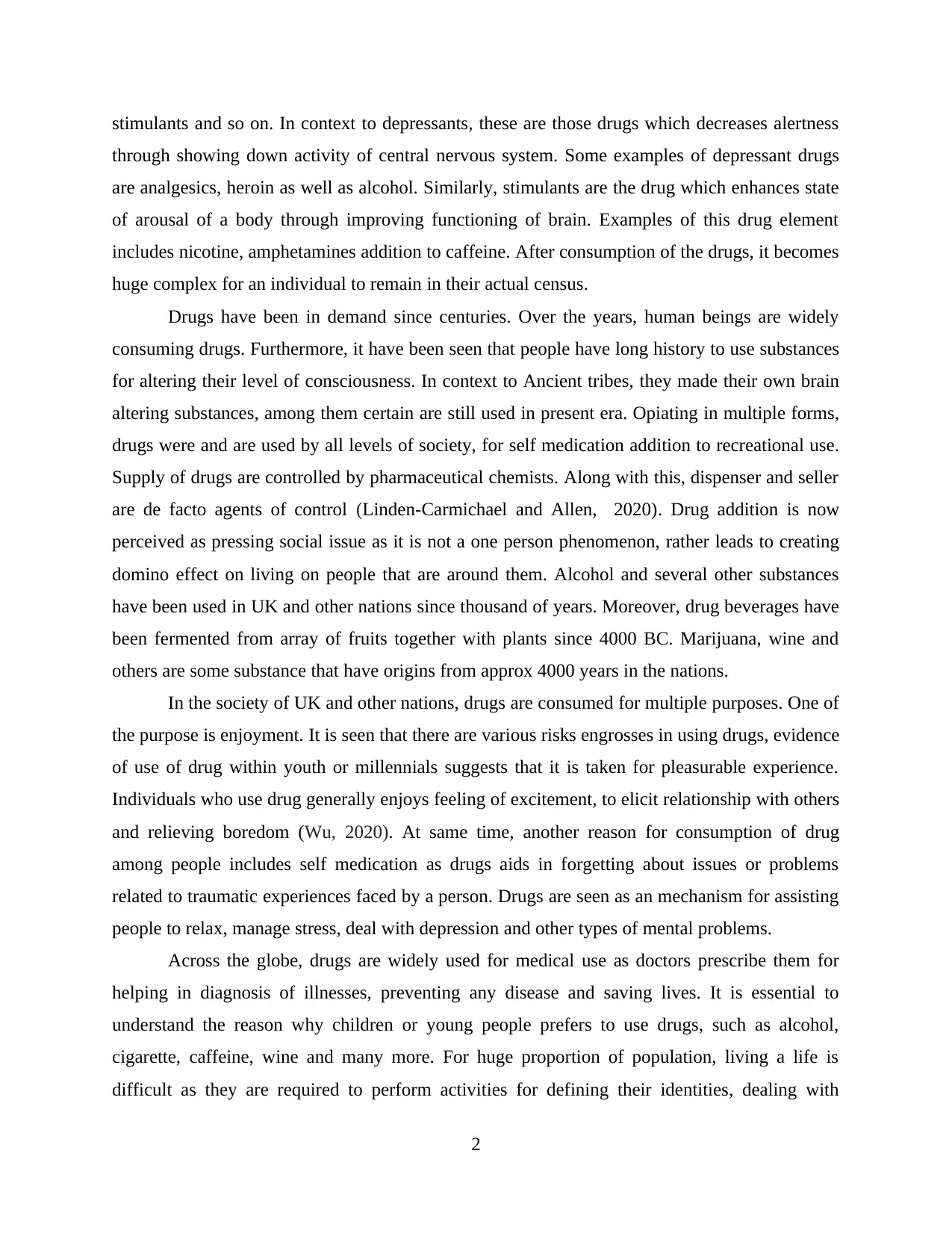
stimulants and so on. In context to depressants, these are those drugs which decreases alertness
through showing down activity of central nervous system. Some examples of depressant drugs
are analgesics, heroin as well as alcohol. Similarly, stimulants are the drug which enhances state
of arousal of a body through improving functioning of brain. Examples of this drug element
includes nicotine, amphetamines addition to caffeine. After consumption of the drugs, it becomes
huge complex for an individual to remain in their actual census.
Drugs have been in demand since centuries. Over the years, human beings are widely
consuming drugs. Furthermore, it have been seen that people have long history to use substances
for altering their level of consciousness. In context to Ancient tribes, they made their own brain
altering substances, among them certain are still used in present era. Opiating in multiple forms,
drugs were and are used by all levels of society, for self medication addition to recreational use.
Supply of drugs are controlled by pharmaceutical chemists. Along with this, dispenser and seller
are de facto agents of control (Linden-Carmichael and Allen, 2020). Drug addition is now
perceived as pressing social issue as it is not a one person phenomenon, rather leads to creating
domino effect on living on people that are around them. Alcohol and several other substances
have been used in UK and other nations since thousand of years. Moreover, drug beverages have
been fermented from array of fruits together with plants since 4000 BC. Marijuana, wine and
others are some substance that have origins from approx 4000 years in the nations.
In the society of UK and other nations, drugs are consumed for multiple purposes. One of
the purpose is enjoyment. It is seen that there are various risks engrosses in using drugs, evidence
of use of drug within youth or millennials suggests that it is taken for pleasurable experience.
Individuals who use drug generally enjoys feeling of excitement, to elicit relationship with others
and relieving boredom (Wu, 2020). At same time, another reason for consumption of drug
among people includes self medication as drugs aids in forgetting about issues or problems
related to traumatic experiences faced by a person. Drugs are seen as an mechanism for assisting
people to relax, manage stress, deal with depression and other types of mental problems.
Across the globe, drugs are widely used for medical use as doctors prescribe them for
helping in diagnosis of illnesses, preventing any disease and saving lives. It is essential to
understand the reason why children or young people prefers to use drugs, such as alcohol,
cigarette, caffeine, wine and many more. For huge proportion of population, living a life is
difficult as they are required to perform activities for defining their identities, dealing with
2
through showing down activity of central nervous system. Some examples of depressant drugs
are analgesics, heroin as well as alcohol. Similarly, stimulants are the drug which enhances state
of arousal of a body through improving functioning of brain. Examples of this drug element
includes nicotine, amphetamines addition to caffeine. After consumption of the drugs, it becomes
huge complex for an individual to remain in their actual census.
Drugs have been in demand since centuries. Over the years, human beings are widely
consuming drugs. Furthermore, it have been seen that people have long history to use substances
for altering their level of consciousness. In context to Ancient tribes, they made their own brain
altering substances, among them certain are still used in present era. Opiating in multiple forms,
drugs were and are used by all levels of society, for self medication addition to recreational use.
Supply of drugs are controlled by pharmaceutical chemists. Along with this, dispenser and seller
are de facto agents of control (Linden-Carmichael and Allen, 2020). Drug addition is now
perceived as pressing social issue as it is not a one person phenomenon, rather leads to creating
domino effect on living on people that are around them. Alcohol and several other substances
have been used in UK and other nations since thousand of years. Moreover, drug beverages have
been fermented from array of fruits together with plants since 4000 BC. Marijuana, wine and
others are some substance that have origins from approx 4000 years in the nations.
In the society of UK and other nations, drugs are consumed for multiple purposes. One of
the purpose is enjoyment. It is seen that there are various risks engrosses in using drugs, evidence
of use of drug within youth or millennials suggests that it is taken for pleasurable experience.
Individuals who use drug generally enjoys feeling of excitement, to elicit relationship with others
and relieving boredom (Wu, 2020). At same time, another reason for consumption of drug
among people includes self medication as drugs aids in forgetting about issues or problems
related to traumatic experiences faced by a person. Drugs are seen as an mechanism for assisting
people to relax, manage stress, deal with depression and other types of mental problems.
Across the globe, drugs are widely used for medical use as doctors prescribe them for
helping in diagnosis of illnesses, preventing any disease and saving lives. It is essential to
understand the reason why children or young people prefers to use drugs, such as alcohol,
cigarette, caffeine, wine and many more. For huge proportion of population, living a life is
difficult as they are required to perform activities for defining their identities, dealing with
2
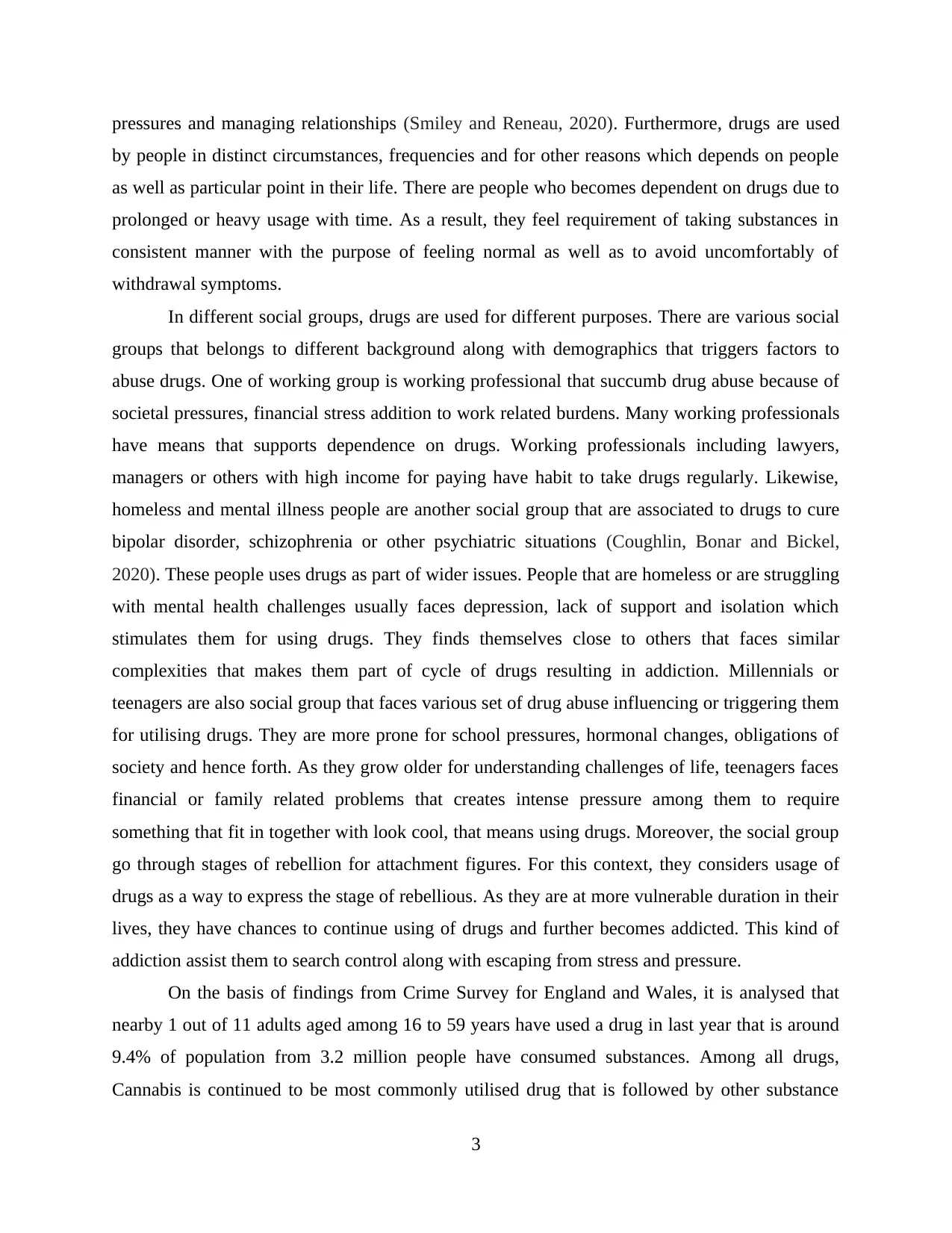
pressures and managing relationships (Smiley and Reneau, 2020). Furthermore, drugs are used
by people in distinct circumstances, frequencies and for other reasons which depends on people
as well as particular point in their life. There are people who becomes dependent on drugs due to
prolonged or heavy usage with time. As a result, they feel requirement of taking substances in
consistent manner with the purpose of feeling normal as well as to avoid uncomfortably of
withdrawal symptoms.
In different social groups, drugs are used for different purposes. There are various social
groups that belongs to different background along with demographics that triggers factors to
abuse drugs. One of working group is working professional that succumb drug abuse because of
societal pressures, financial stress addition to work related burdens. Many working professionals
have means that supports dependence on drugs. Working professionals including lawyers,
managers or others with high income for paying have habit to take drugs regularly. Likewise,
homeless and mental illness people are another social group that are associated to drugs to cure
bipolar disorder, schizophrenia or other psychiatric situations (Coughlin, Bonar and Bickel,
2020). These people uses drugs as part of wider issues. People that are homeless or are struggling
with mental health challenges usually faces depression, lack of support and isolation which
stimulates them for using drugs. They finds themselves close to others that faces similar
complexities that makes them part of cycle of drugs resulting in addiction. Millennials or
teenagers are also social group that faces various set of drug abuse influencing or triggering them
for utilising drugs. They are more prone for school pressures, hormonal changes, obligations of
society and hence forth. As they grow older for understanding challenges of life, teenagers faces
financial or family related problems that creates intense pressure among them to require
something that fit in together with look cool, that means using drugs. Moreover, the social group
go through stages of rebellion for attachment figures. For this context, they considers usage of
drugs as a way to express the stage of rebellious. As they are at more vulnerable duration in their
lives, they have chances to continue using of drugs and further becomes addicted. This kind of
addiction assist them to search control along with escaping from stress and pressure.
On the basis of findings from Crime Survey for England and Wales, it is analysed that
nearby 1 out of 11 adults aged among 16 to 59 years have used a drug in last year that is around
9.4% of population from 3.2 million people have consumed substances. Among all drugs,
Cannabis is continued to be most commonly utilised drug that is followed by other substance
3
by people in distinct circumstances, frequencies and for other reasons which depends on people
as well as particular point in their life. There are people who becomes dependent on drugs due to
prolonged or heavy usage with time. As a result, they feel requirement of taking substances in
consistent manner with the purpose of feeling normal as well as to avoid uncomfortably of
withdrawal symptoms.
In different social groups, drugs are used for different purposes. There are various social
groups that belongs to different background along with demographics that triggers factors to
abuse drugs. One of working group is working professional that succumb drug abuse because of
societal pressures, financial stress addition to work related burdens. Many working professionals
have means that supports dependence on drugs. Working professionals including lawyers,
managers or others with high income for paying have habit to take drugs regularly. Likewise,
homeless and mental illness people are another social group that are associated to drugs to cure
bipolar disorder, schizophrenia or other psychiatric situations (Coughlin, Bonar and Bickel,
2020). These people uses drugs as part of wider issues. People that are homeless or are struggling
with mental health challenges usually faces depression, lack of support and isolation which
stimulates them for using drugs. They finds themselves close to others that faces similar
complexities that makes them part of cycle of drugs resulting in addiction. Millennials or
teenagers are also social group that faces various set of drug abuse influencing or triggering them
for utilising drugs. They are more prone for school pressures, hormonal changes, obligations of
society and hence forth. As they grow older for understanding challenges of life, teenagers faces
financial or family related problems that creates intense pressure among them to require
something that fit in together with look cool, that means using drugs. Moreover, the social group
go through stages of rebellion for attachment figures. For this context, they considers usage of
drugs as a way to express the stage of rebellious. As they are at more vulnerable duration in their
lives, they have chances to continue using of drugs and further becomes addicted. This kind of
addiction assist them to search control along with escaping from stress and pressure.
On the basis of findings from Crime Survey for England and Wales, it is analysed that
nearby 1 out of 11 adults aged among 16 to 59 years have used a drug in last year that is around
9.4% of population from 3.2 million people have consumed substances. Among all drugs,
Cannabis is continued to be most commonly utilised drug that is followed by other substance
3
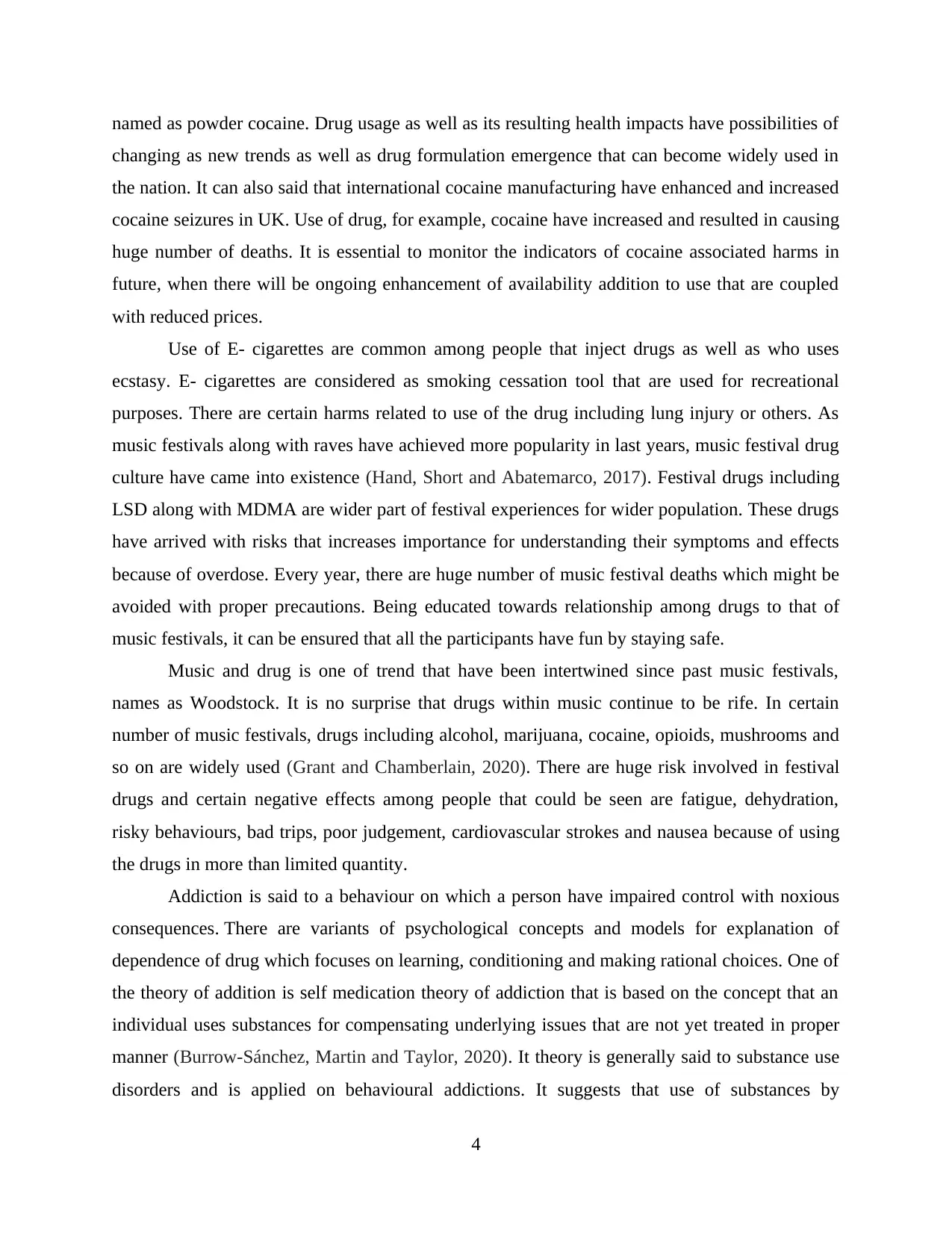
named as powder cocaine. Drug usage as well as its resulting health impacts have possibilities of
changing as new trends as well as drug formulation emergence that can become widely used in
the nation. It can also said that international cocaine manufacturing have enhanced and increased
cocaine seizures in UK. Use of drug, for example, cocaine have increased and resulted in causing
huge number of deaths. It is essential to monitor the indicators of cocaine associated harms in
future, when there will be ongoing enhancement of availability addition to use that are coupled
with reduced prices.
Use of E- cigarettes are common among people that inject drugs as well as who uses
ecstasy. E- cigarettes are considered as smoking cessation tool that are used for recreational
purposes. There are certain harms related to use of the drug including lung injury or others. As
music festivals along with raves have achieved more popularity in last years, music festival drug
culture have came into existence (Hand, Short and Abatemarco, 2017). Festival drugs including
LSD along with MDMA are wider part of festival experiences for wider population. These drugs
have arrived with risks that increases importance for understanding their symptoms and effects
because of overdose. Every year, there are huge number of music festival deaths which might be
avoided with proper precautions. Being educated towards relationship among drugs to that of
music festivals, it can be ensured that all the participants have fun by staying safe.
Music and drug is one of trend that have been intertwined since past music festivals,
names as Woodstock. It is no surprise that drugs within music continue to be rife. In certain
number of music festivals, drugs including alcohol, marijuana, cocaine, opioids, mushrooms and
so on are widely used (Grant and Chamberlain, 2020). There are huge risk involved in festival
drugs and certain negative effects among people that could be seen are fatigue, dehydration,
risky behaviours, bad trips, poor judgement, cardiovascular strokes and nausea because of using
the drugs in more than limited quantity.
Addiction is said to a behaviour on which a person have impaired control with noxious
consequences. There are variants of psychological concepts and models for explanation of
dependence of drug which focuses on learning, conditioning and making rational choices. One of
the theory of addition is self medication theory of addiction that is based on the concept that an
individual uses substances for compensating underlying issues that are not yet treated in proper
manner (Burrow-Sánchez, Martin and Taylor, 2020). It theory is generally said to substance use
disorders and is applied on behavioural addictions. It suggests that use of substances by
4
changing as new trends as well as drug formulation emergence that can become widely used in
the nation. It can also said that international cocaine manufacturing have enhanced and increased
cocaine seizures in UK. Use of drug, for example, cocaine have increased and resulted in causing
huge number of deaths. It is essential to monitor the indicators of cocaine associated harms in
future, when there will be ongoing enhancement of availability addition to use that are coupled
with reduced prices.
Use of E- cigarettes are common among people that inject drugs as well as who uses
ecstasy. E- cigarettes are considered as smoking cessation tool that are used for recreational
purposes. There are certain harms related to use of the drug including lung injury or others. As
music festivals along with raves have achieved more popularity in last years, music festival drug
culture have came into existence (Hand, Short and Abatemarco, 2017). Festival drugs including
LSD along with MDMA are wider part of festival experiences for wider population. These drugs
have arrived with risks that increases importance for understanding their symptoms and effects
because of overdose. Every year, there are huge number of music festival deaths which might be
avoided with proper precautions. Being educated towards relationship among drugs to that of
music festivals, it can be ensured that all the participants have fun by staying safe.
Music and drug is one of trend that have been intertwined since past music festivals,
names as Woodstock. It is no surprise that drugs within music continue to be rife. In certain
number of music festivals, drugs including alcohol, marijuana, cocaine, opioids, mushrooms and
so on are widely used (Grant and Chamberlain, 2020). There are huge risk involved in festival
drugs and certain negative effects among people that could be seen are fatigue, dehydration,
risky behaviours, bad trips, poor judgement, cardiovascular strokes and nausea because of using
the drugs in more than limited quantity.
Addiction is said to a behaviour on which a person have impaired control with noxious
consequences. There are variants of psychological concepts and models for explanation of
dependence of drug which focuses on learning, conditioning and making rational choices. One of
the theory of addition is self medication theory of addiction that is based on the concept that an
individual uses substances for compensating underlying issues that are not yet treated in proper
manner (Burrow-Sánchez, Martin and Taylor, 2020). It theory is generally said to substance use
disorders and is applied on behavioural addictions. It suggests that use of substances by
4
Paraphrase This Document
Need a fresh take? Get an instant paraphrase of this document with our AI Paraphraser
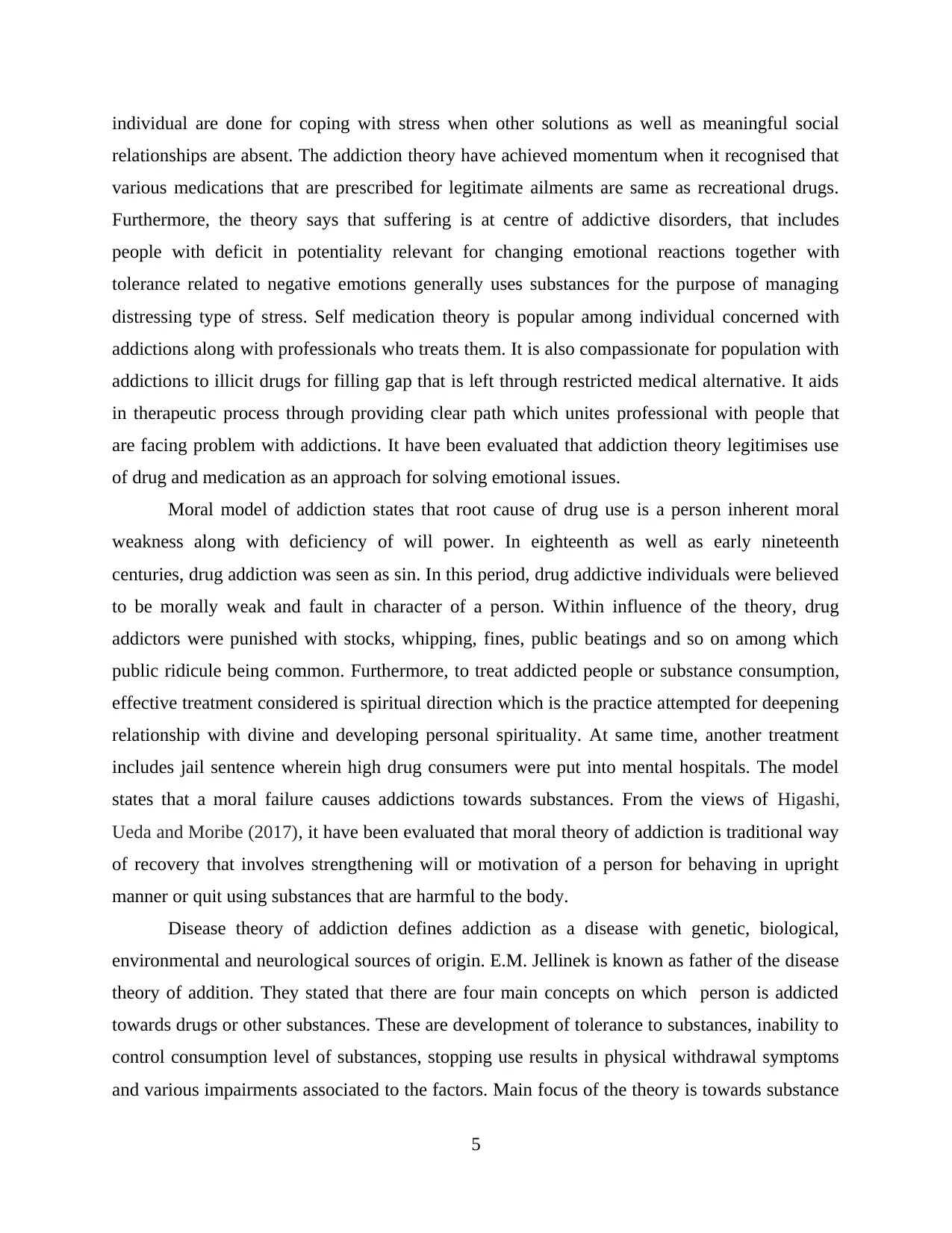
individual are done for coping with stress when other solutions as well as meaningful social
relationships are absent. The addiction theory have achieved momentum when it recognised that
various medications that are prescribed for legitimate ailments are same as recreational drugs.
Furthermore, the theory says that suffering is at centre of addictive disorders, that includes
people with deficit in potentiality relevant for changing emotional reactions together with
tolerance related to negative emotions generally uses substances for the purpose of managing
distressing type of stress. Self medication theory is popular among individual concerned with
addictions along with professionals who treats them. It is also compassionate for population with
addictions to illicit drugs for filling gap that is left through restricted medical alternative. It aids
in therapeutic process through providing clear path which unites professional with people that
are facing problem with addictions. It have been evaluated that addiction theory legitimises use
of drug and medication as an approach for solving emotional issues.
Moral model of addiction states that root cause of drug use is a person inherent moral
weakness along with deficiency of will power. In eighteenth as well as early nineteenth
centuries, drug addiction was seen as sin. In this period, drug addictive individuals were believed
to be morally weak and fault in character of a person. Within influence of the theory, drug
addictors were punished with stocks, whipping, fines, public beatings and so on among which
public ridicule being common. Furthermore, to treat addicted people or substance consumption,
effective treatment considered is spiritual direction which is the practice attempted for deepening
relationship with divine and developing personal spirituality. At same time, another treatment
includes jail sentence wherein high drug consumers were put into mental hospitals. The model
states that a moral failure causes addictions towards substances. From the views of Higashi,
Ueda and Moribe (2017), it have been evaluated that moral theory of addiction is traditional way
of recovery that involves strengthening will or motivation of a person for behaving in upright
manner or quit using substances that are harmful to the body.
Disease theory of addiction defines addiction as a disease with genetic, biological,
environmental and neurological sources of origin. E.M. Jellinek is known as father of the disease
theory of addition. They stated that there are four main concepts on which person is addicted
towards drugs or other substances. These are development of tolerance to substances, inability to
control consumption level of substances, stopping use results in physical withdrawal symptoms
and various impairments associated to the factors. Main focus of the theory is towards substance
5
relationships are absent. The addiction theory have achieved momentum when it recognised that
various medications that are prescribed for legitimate ailments are same as recreational drugs.
Furthermore, the theory says that suffering is at centre of addictive disorders, that includes
people with deficit in potentiality relevant for changing emotional reactions together with
tolerance related to negative emotions generally uses substances for the purpose of managing
distressing type of stress. Self medication theory is popular among individual concerned with
addictions along with professionals who treats them. It is also compassionate for population with
addictions to illicit drugs for filling gap that is left through restricted medical alternative. It aids
in therapeutic process through providing clear path which unites professional with people that
are facing problem with addictions. It have been evaluated that addiction theory legitimises use
of drug and medication as an approach for solving emotional issues.
Moral model of addiction states that root cause of drug use is a person inherent moral
weakness along with deficiency of will power. In eighteenth as well as early nineteenth
centuries, drug addiction was seen as sin. In this period, drug addictive individuals were believed
to be morally weak and fault in character of a person. Within influence of the theory, drug
addictors were punished with stocks, whipping, fines, public beatings and so on among which
public ridicule being common. Furthermore, to treat addicted people or substance consumption,
effective treatment considered is spiritual direction which is the practice attempted for deepening
relationship with divine and developing personal spirituality. At same time, another treatment
includes jail sentence wherein high drug consumers were put into mental hospitals. The model
states that a moral failure causes addictions towards substances. From the views of Higashi,
Ueda and Moribe (2017), it have been evaluated that moral theory of addiction is traditional way
of recovery that involves strengthening will or motivation of a person for behaving in upright
manner or quit using substances that are harmful to the body.
Disease theory of addiction defines addiction as a disease with genetic, biological,
environmental and neurological sources of origin. E.M. Jellinek is known as father of the disease
theory of addition. They stated that there are four main concepts on which person is addicted
towards drugs or other substances. These are development of tolerance to substances, inability to
control consumption level of substances, stopping use results in physical withdrawal symptoms
and various impairments associated to the factors. Main focus of the theory is towards substance
5
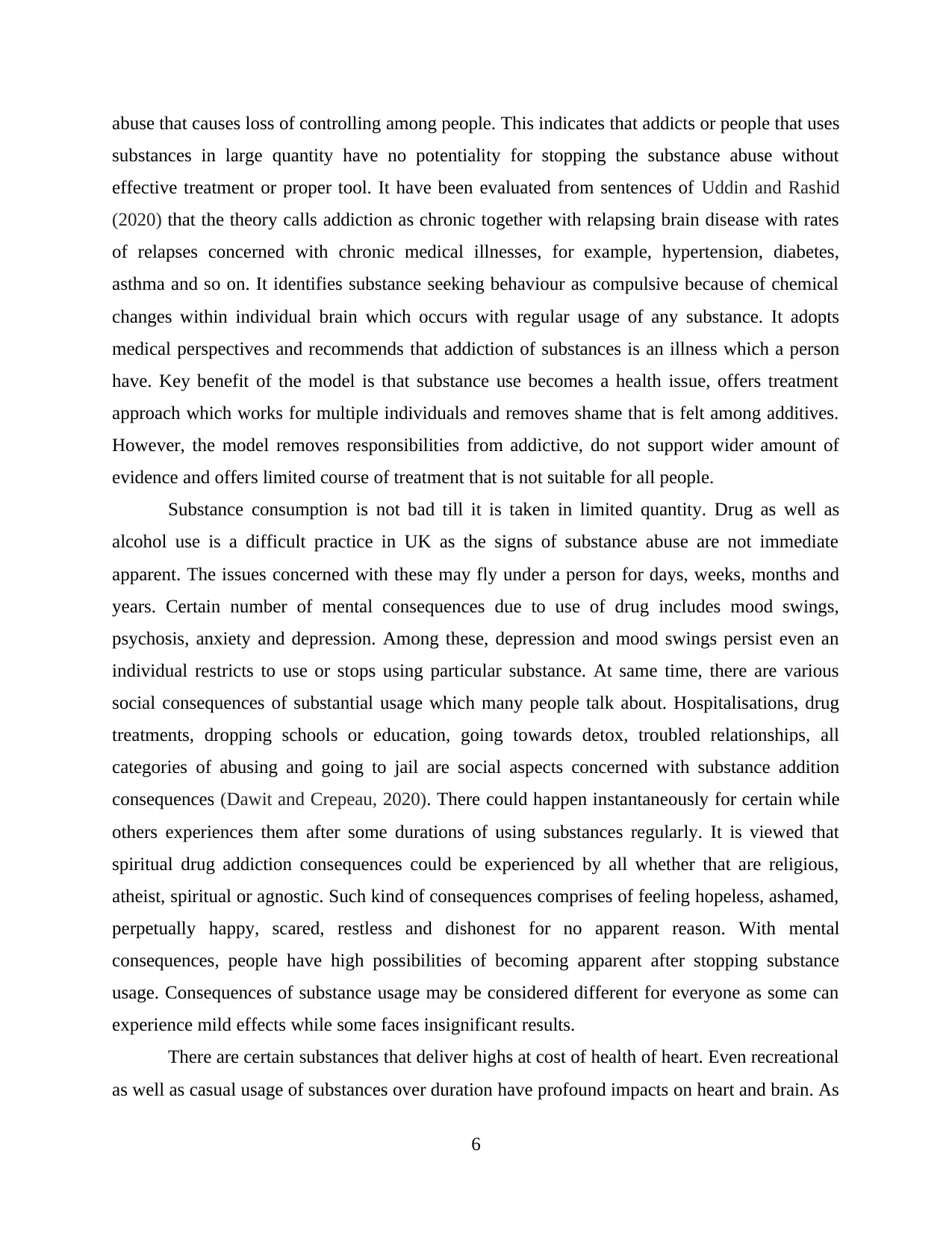
abuse that causes loss of controlling among people. This indicates that addicts or people that uses
substances in large quantity have no potentiality for stopping the substance abuse without
effective treatment or proper tool. It have been evaluated from sentences of Uddin and Rashid
(2020) that the theory calls addiction as chronic together with relapsing brain disease with rates
of relapses concerned with chronic medical illnesses, for example, hypertension, diabetes,
asthma and so on. It identifies substance seeking behaviour as compulsive because of chemical
changes within individual brain which occurs with regular usage of any substance. It adopts
medical perspectives and recommends that addiction of substances is an illness which a person
have. Key benefit of the model is that substance use becomes a health issue, offers treatment
approach which works for multiple individuals and removes shame that is felt among additives.
However, the model removes responsibilities from addictive, do not support wider amount of
evidence and offers limited course of treatment that is not suitable for all people.
Substance consumption is not bad till it is taken in limited quantity. Drug as well as
alcohol use is a difficult practice in UK as the signs of substance abuse are not immediate
apparent. The issues concerned with these may fly under a person for days, weeks, months and
years. Certain number of mental consequences due to use of drug includes mood swings,
psychosis, anxiety and depression. Among these, depression and mood swings persist even an
individual restricts to use or stops using particular substance. At same time, there are various
social consequences of substantial usage which many people talk about. Hospitalisations, drug
treatments, dropping schools or education, going towards detox, troubled relationships, all
categories of abusing and going to jail are social aspects concerned with substance addition
consequences (Dawit and Crepeau, 2020). There could happen instantaneously for certain while
others experiences them after some durations of using substances regularly. It is viewed that
spiritual drug addiction consequences could be experienced by all whether that are religious,
atheist, spiritual or agnostic. Such kind of consequences comprises of feeling hopeless, ashamed,
perpetually happy, scared, restless and dishonest for no apparent reason. With mental
consequences, people have high possibilities of becoming apparent after stopping substance
usage. Consequences of substance usage may be considered different for everyone as some can
experience mild effects while some faces insignificant results.
There are certain substances that deliver highs at cost of health of heart. Even recreational
as well as casual usage of substances over duration have profound impacts on heart and brain. As
6
substances in large quantity have no potentiality for stopping the substance abuse without
effective treatment or proper tool. It have been evaluated from sentences of Uddin and Rashid
(2020) that the theory calls addiction as chronic together with relapsing brain disease with rates
of relapses concerned with chronic medical illnesses, for example, hypertension, diabetes,
asthma and so on. It identifies substance seeking behaviour as compulsive because of chemical
changes within individual brain which occurs with regular usage of any substance. It adopts
medical perspectives and recommends that addiction of substances is an illness which a person
have. Key benefit of the model is that substance use becomes a health issue, offers treatment
approach which works for multiple individuals and removes shame that is felt among additives.
However, the model removes responsibilities from addictive, do not support wider amount of
evidence and offers limited course of treatment that is not suitable for all people.
Substance consumption is not bad till it is taken in limited quantity. Drug as well as
alcohol use is a difficult practice in UK as the signs of substance abuse are not immediate
apparent. The issues concerned with these may fly under a person for days, weeks, months and
years. Certain number of mental consequences due to use of drug includes mood swings,
psychosis, anxiety and depression. Among these, depression and mood swings persist even an
individual restricts to use or stops using particular substance. At same time, there are various
social consequences of substantial usage which many people talk about. Hospitalisations, drug
treatments, dropping schools or education, going towards detox, troubled relationships, all
categories of abusing and going to jail are social aspects concerned with substance addition
consequences (Dawit and Crepeau, 2020). There could happen instantaneously for certain while
others experiences them after some durations of using substances regularly. It is viewed that
spiritual drug addiction consequences could be experienced by all whether that are religious,
atheist, spiritual or agnostic. Such kind of consequences comprises of feeling hopeless, ashamed,
perpetually happy, scared, restless and dishonest for no apparent reason. With mental
consequences, people have high possibilities of becoming apparent after stopping substance
usage. Consequences of substance usage may be considered different for everyone as some can
experience mild effects while some faces insignificant results.
There are certain substances that deliver highs at cost of health of heart. Even recreational
as well as casual usage of substances over duration have profound impacts on heart and brain. As
6
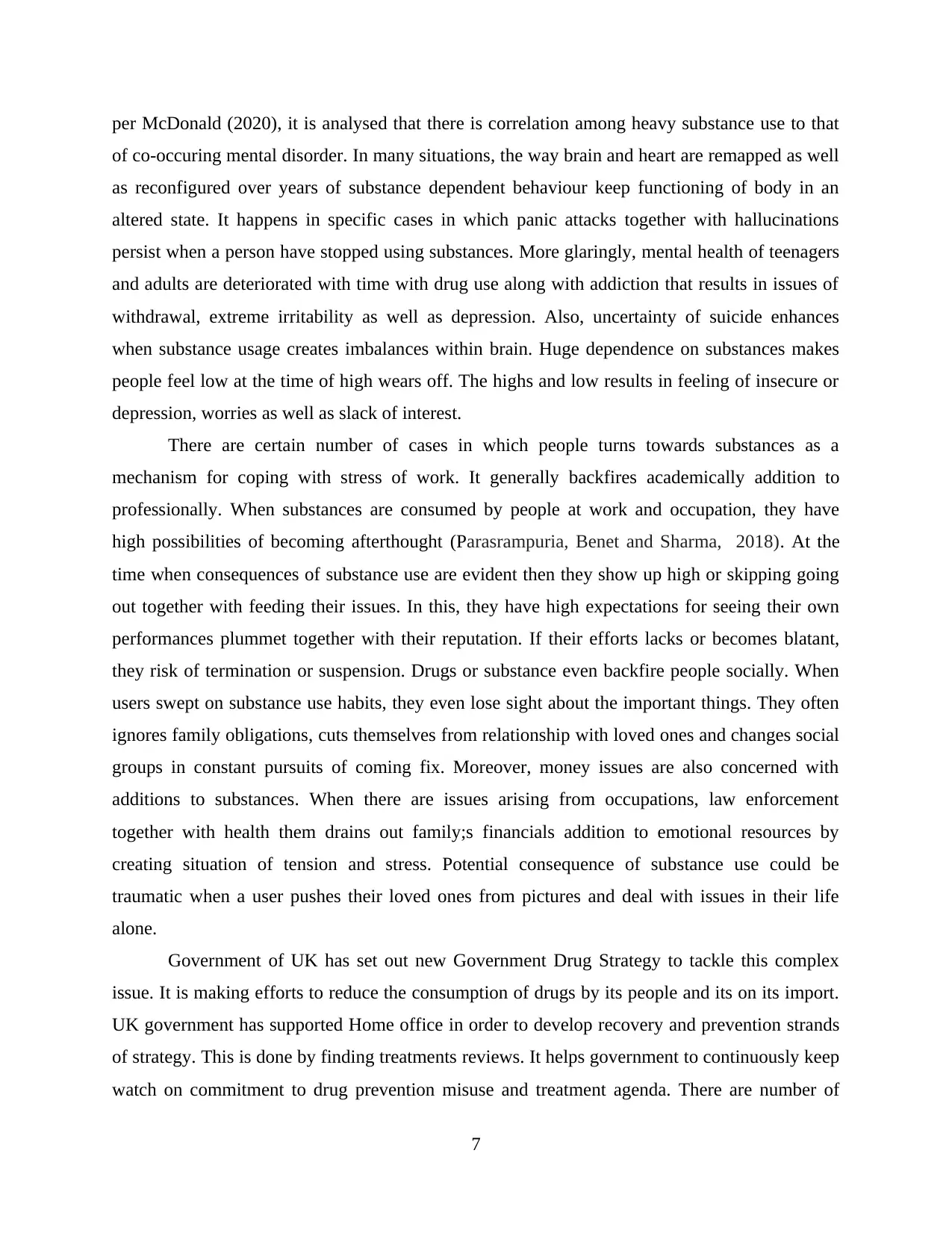
per McDonald (2020), it is analysed that there is correlation among heavy substance use to that
of co-occuring mental disorder. In many situations, the way brain and heart are remapped as well
as reconfigured over years of substance dependent behaviour keep functioning of body in an
altered state. It happens in specific cases in which panic attacks together with hallucinations
persist when a person have stopped using substances. More glaringly, mental health of teenagers
and adults are deteriorated with time with drug use along with addiction that results in issues of
withdrawal, extreme irritability as well as depression. Also, uncertainty of suicide enhances
when substance usage creates imbalances within brain. Huge dependence on substances makes
people feel low at the time of high wears off. The highs and low results in feeling of insecure or
depression, worries as well as slack of interest.
There are certain number of cases in which people turns towards substances as a
mechanism for coping with stress of work. It generally backfires academically addition to
professionally. When substances are consumed by people at work and occupation, they have
high possibilities of becoming afterthought (Parasrampuria, Benet and Sharma, 2018). At the
time when consequences of substance use are evident then they show up high or skipping going
out together with feeding their issues. In this, they have high expectations for seeing their own
performances plummet together with their reputation. If their efforts lacks or becomes blatant,
they risk of termination or suspension. Drugs or substance even backfire people socially. When
users swept on substance use habits, they even lose sight about the important things. They often
ignores family obligations, cuts themselves from relationship with loved ones and changes social
groups in constant pursuits of coming fix. Moreover, money issues are also concerned with
additions to substances. When there are issues arising from occupations, law enforcement
together with health them drains out family;s financials addition to emotional resources by
creating situation of tension and stress. Potential consequence of substance use could be
traumatic when a user pushes their loved ones from pictures and deal with issues in their life
alone.
Government of UK has set out new Government Drug Strategy to tackle this complex
issue. It is making efforts to reduce the consumption of drugs by its people and its on its import.
UK government has supported Home office in order to develop recovery and prevention strands
of strategy. This is done by finding treatments reviews. It helps government to continuously keep
watch on commitment to drug prevention misuse and treatment agenda. There are number of
7
of co-occuring mental disorder. In many situations, the way brain and heart are remapped as well
as reconfigured over years of substance dependent behaviour keep functioning of body in an
altered state. It happens in specific cases in which panic attacks together with hallucinations
persist when a person have stopped using substances. More glaringly, mental health of teenagers
and adults are deteriorated with time with drug use along with addiction that results in issues of
withdrawal, extreme irritability as well as depression. Also, uncertainty of suicide enhances
when substance usage creates imbalances within brain. Huge dependence on substances makes
people feel low at the time of high wears off. The highs and low results in feeling of insecure or
depression, worries as well as slack of interest.
There are certain number of cases in which people turns towards substances as a
mechanism for coping with stress of work. It generally backfires academically addition to
professionally. When substances are consumed by people at work and occupation, they have
high possibilities of becoming afterthought (Parasrampuria, Benet and Sharma, 2018). At the
time when consequences of substance use are evident then they show up high or skipping going
out together with feeding their issues. In this, they have high expectations for seeing their own
performances plummet together with their reputation. If their efforts lacks or becomes blatant,
they risk of termination or suspension. Drugs or substance even backfire people socially. When
users swept on substance use habits, they even lose sight about the important things. They often
ignores family obligations, cuts themselves from relationship with loved ones and changes social
groups in constant pursuits of coming fix. Moreover, money issues are also concerned with
additions to substances. When there are issues arising from occupations, law enforcement
together with health them drains out family;s financials addition to emotional resources by
creating situation of tension and stress. Potential consequence of substance use could be
traumatic when a user pushes their loved ones from pictures and deal with issues in their life
alone.
Government of UK has set out new Government Drug Strategy to tackle this complex
issue. It is making efforts to reduce the consumption of drugs by its people and its on its import.
UK government has supported Home office in order to develop recovery and prevention strands
of strategy. This is done by finding treatments reviews. It helps government to continuously keep
watch on commitment to drug prevention misuse and treatment agenda. There are number of
7
Secure Best Marks with AI Grader
Need help grading? Try our AI Grader for instant feedback on your assignments.
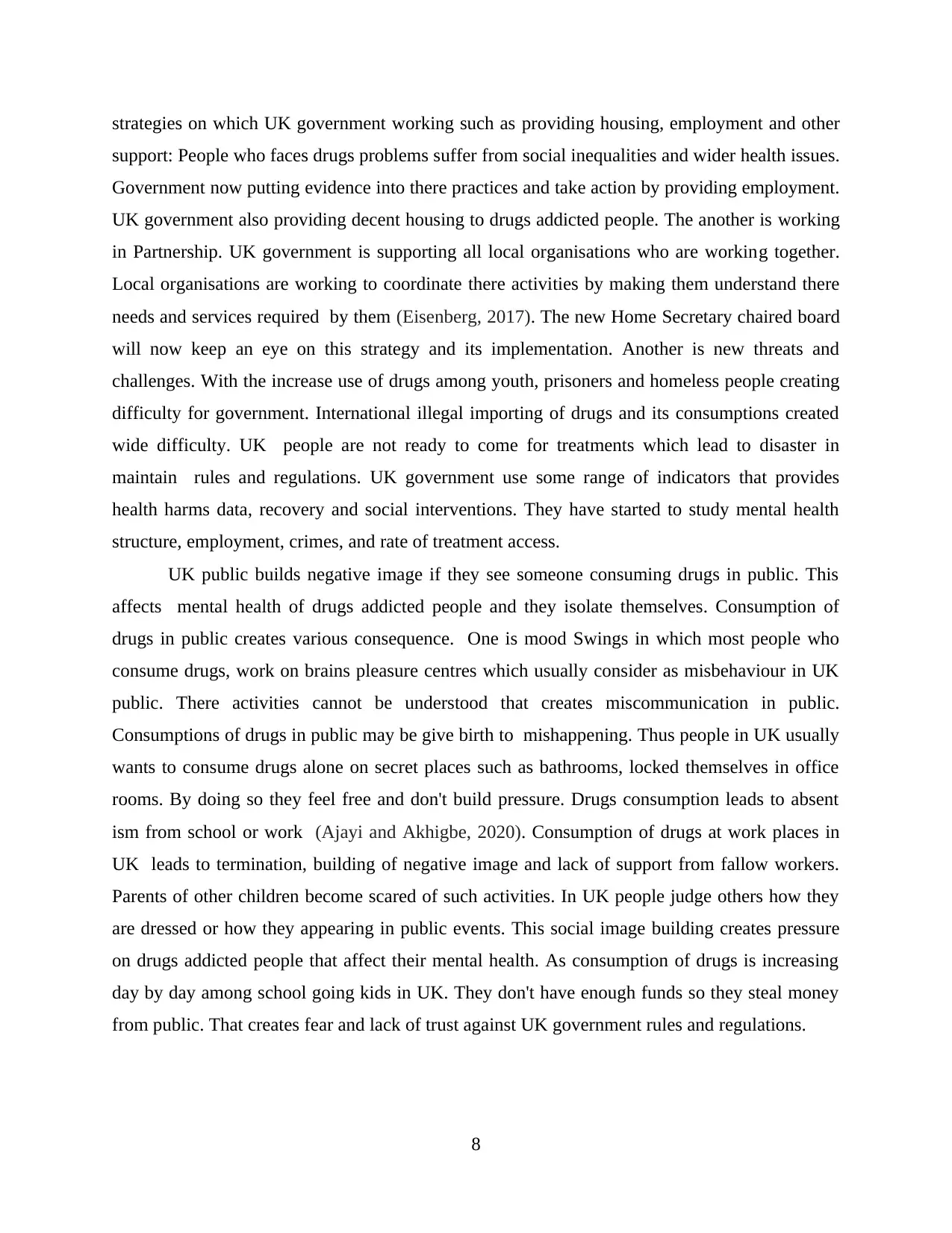
strategies on which UK government working such as providing housing, employment and other
support: People who faces drugs problems suffer from social inequalities and wider health issues.
Government now putting evidence into there practices and take action by providing employment.
UK government also providing decent housing to drugs addicted people. The another is working
in Partnership. UK government is supporting all local organisations who are working together.
Local organisations are working to coordinate there activities by making them understand there
needs and services required by them (Eisenberg, 2017). The new Home Secretary chaired board
will now keep an eye on this strategy and its implementation. Another is new threats and
challenges. With the increase use of drugs among youth, prisoners and homeless people creating
difficulty for government. International illegal importing of drugs and its consumptions created
wide difficulty. UK people are not ready to come for treatments which lead to disaster in
maintain rules and regulations. UK government use some range of indicators that provides
health harms data, recovery and social interventions. They have started to study mental health
structure, employment, crimes, and rate of treatment access.
UK public builds negative image if they see someone consuming drugs in public. This
affects mental health of drugs addicted people and they isolate themselves. Consumption of
drugs in public creates various consequence. One is mood Swings in which most people who
consume drugs, work on brains pleasure centres which usually consider as misbehaviour in UK
public. There activities cannot be understood that creates miscommunication in public.
Consumptions of drugs in public may be give birth to mishappening. Thus people in UK usually
wants to consume drugs alone on secret places such as bathrooms, locked themselves in office
rooms. By doing so they feel free and don't build pressure. Drugs consumption leads to absent
ism from school or work (Ajayi and Akhigbe, 2020). Consumption of drugs at work places in
UK leads to termination, building of negative image and lack of support from fallow workers.
Parents of other children become scared of such activities. In UK people judge others how they
are dressed or how they appearing in public events. This social image building creates pressure
on drugs addicted people that affect their mental health. As consumption of drugs is increasing
day by day among school going kids in UK. They don't have enough funds so they steal money
from public. That creates fear and lack of trust against UK government rules and regulations.
8
support: People who faces drugs problems suffer from social inequalities and wider health issues.
Government now putting evidence into there practices and take action by providing employment.
UK government also providing decent housing to drugs addicted people. The another is working
in Partnership. UK government is supporting all local organisations who are working together.
Local organisations are working to coordinate there activities by making them understand there
needs and services required by them (Eisenberg, 2017). The new Home Secretary chaired board
will now keep an eye on this strategy and its implementation. Another is new threats and
challenges. With the increase use of drugs among youth, prisoners and homeless people creating
difficulty for government. International illegal importing of drugs and its consumptions created
wide difficulty. UK people are not ready to come for treatments which lead to disaster in
maintain rules and regulations. UK government use some range of indicators that provides
health harms data, recovery and social interventions. They have started to study mental health
structure, employment, crimes, and rate of treatment access.
UK public builds negative image if they see someone consuming drugs in public. This
affects mental health of drugs addicted people and they isolate themselves. Consumption of
drugs in public creates various consequence. One is mood Swings in which most people who
consume drugs, work on brains pleasure centres which usually consider as misbehaviour in UK
public. There activities cannot be understood that creates miscommunication in public.
Consumptions of drugs in public may be give birth to mishappening. Thus people in UK usually
wants to consume drugs alone on secret places such as bathrooms, locked themselves in office
rooms. By doing so they feel free and don't build pressure. Drugs consumption leads to absent
ism from school or work (Ajayi and Akhigbe, 2020). Consumption of drugs at work places in
UK leads to termination, building of negative image and lack of support from fallow workers.
Parents of other children become scared of such activities. In UK people judge others how they
are dressed or how they appearing in public events. This social image building creates pressure
on drugs addicted people that affect their mental health. As consumption of drugs is increasing
day by day among school going kids in UK. They don't have enough funds so they steal money
from public. That creates fear and lack of trust against UK government rules and regulations.
8
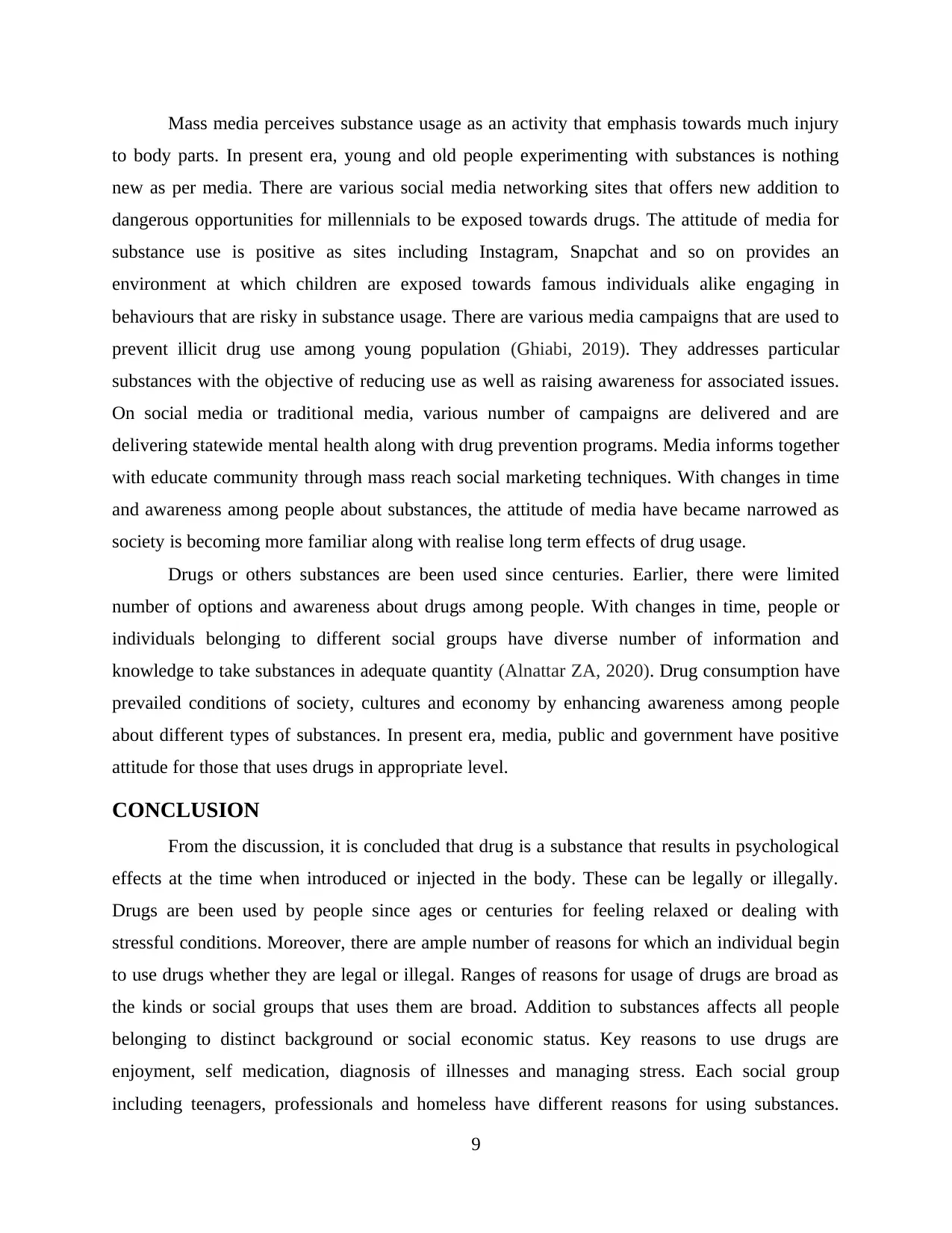
Mass media perceives substance usage as an activity that emphasis towards much injury
to body parts. In present era, young and old people experimenting with substances is nothing
new as per media. There are various social media networking sites that offers new addition to
dangerous opportunities for millennials to be exposed towards drugs. The attitude of media for
substance use is positive as sites including Instagram, Snapchat and so on provides an
environment at which children are exposed towards famous individuals alike engaging in
behaviours that are risky in substance usage. There are various media campaigns that are used to
prevent illicit drug use among young population (Ghiabi, 2019). They addresses particular
substances with the objective of reducing use as well as raising awareness for associated issues.
On social media or traditional media, various number of campaigns are delivered and are
delivering statewide mental health along with drug prevention programs. Media informs together
with educate community through mass reach social marketing techniques. With changes in time
and awareness among people about substances, the attitude of media have became narrowed as
society is becoming more familiar along with realise long term effects of drug usage.
Drugs or others substances are been used since centuries. Earlier, there were limited
number of options and awareness about drugs among people. With changes in time, people or
individuals belonging to different social groups have diverse number of information and
knowledge to take substances in adequate quantity (Alnattar ZA, 2020). Drug consumption have
prevailed conditions of society, cultures and economy by enhancing awareness among people
about different types of substances. In present era, media, public and government have positive
attitude for those that uses drugs in appropriate level.
CONCLUSION
From the discussion, it is concluded that drug is a substance that results in psychological
effects at the time when introduced or injected in the body. These can be legally or illegally.
Drugs are been used by people since ages or centuries for feeling relaxed or dealing with
stressful conditions. Moreover, there are ample number of reasons for which an individual begin
to use drugs whether they are legal or illegal. Ranges of reasons for usage of drugs are broad as
the kinds or social groups that uses them are broad. Addition to substances affects all people
belonging to distinct background or social economic status. Key reasons to use drugs are
enjoyment, self medication, diagnosis of illnesses and managing stress. Each social group
including teenagers, professionals and homeless have different reasons for using substances.
9
to body parts. In present era, young and old people experimenting with substances is nothing
new as per media. There are various social media networking sites that offers new addition to
dangerous opportunities for millennials to be exposed towards drugs. The attitude of media for
substance use is positive as sites including Instagram, Snapchat and so on provides an
environment at which children are exposed towards famous individuals alike engaging in
behaviours that are risky in substance usage. There are various media campaigns that are used to
prevent illicit drug use among young population (Ghiabi, 2019). They addresses particular
substances with the objective of reducing use as well as raising awareness for associated issues.
On social media or traditional media, various number of campaigns are delivered and are
delivering statewide mental health along with drug prevention programs. Media informs together
with educate community through mass reach social marketing techniques. With changes in time
and awareness among people about substances, the attitude of media have became narrowed as
society is becoming more familiar along with realise long term effects of drug usage.
Drugs or others substances are been used since centuries. Earlier, there were limited
number of options and awareness about drugs among people. With changes in time, people or
individuals belonging to different social groups have diverse number of information and
knowledge to take substances in adequate quantity (Alnattar ZA, 2020). Drug consumption have
prevailed conditions of society, cultures and economy by enhancing awareness among people
about different types of substances. In present era, media, public and government have positive
attitude for those that uses drugs in appropriate level.
CONCLUSION
From the discussion, it is concluded that drug is a substance that results in psychological
effects at the time when introduced or injected in the body. These can be legally or illegally.
Drugs are been used by people since ages or centuries for feeling relaxed or dealing with
stressful conditions. Moreover, there are ample number of reasons for which an individual begin
to use drugs whether they are legal or illegal. Ranges of reasons for usage of drugs are broad as
the kinds or social groups that uses them are broad. Addition to substances affects all people
belonging to distinct background or social economic status. Key reasons to use drugs are
enjoyment, self medication, diagnosis of illnesses and managing stress. Each social group
including teenagers, professionals and homeless have different reasons for using substances.
9
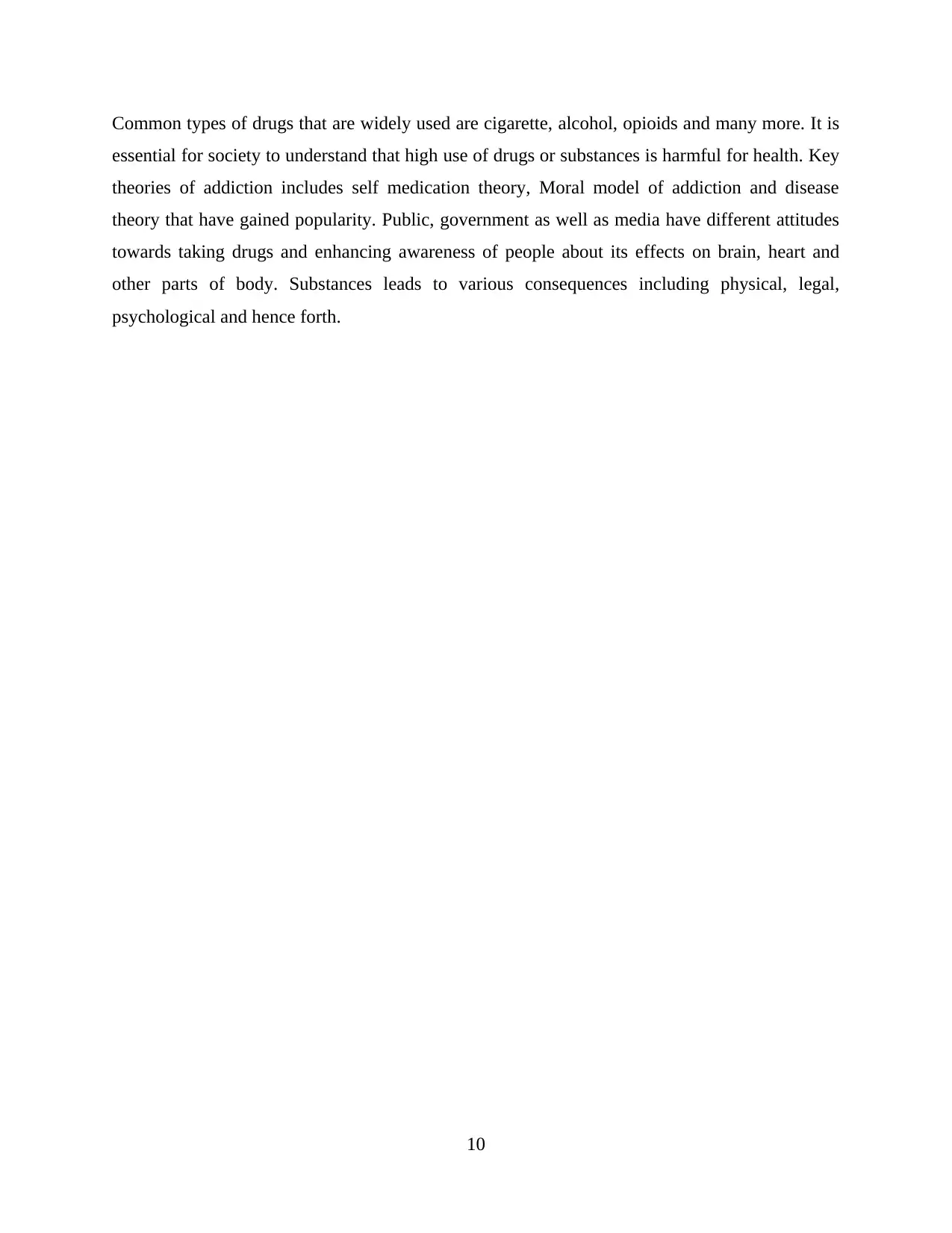
Common types of drugs that are widely used are cigarette, alcohol, opioids and many more. It is
essential for society to understand that high use of drugs or substances is harmful for health. Key
theories of addiction includes self medication theory, Moral model of addiction and disease
theory that have gained popularity. Public, government as well as media have different attitudes
towards taking drugs and enhancing awareness of people about its effects on brain, heart and
other parts of body. Substances leads to various consequences including physical, legal,
psychological and hence forth.
10
essential for society to understand that high use of drugs or substances is harmful for health. Key
theories of addiction includes self medication theory, Moral model of addiction and disease
theory that have gained popularity. Public, government as well as media have different attitudes
towards taking drugs and enhancing awareness of people about its effects on brain, heart and
other parts of body. Substances leads to various consequences including physical, legal,
psychological and hence forth.
10
Paraphrase This Document
Need a fresh take? Get an instant paraphrase of this document with our AI Paraphraser
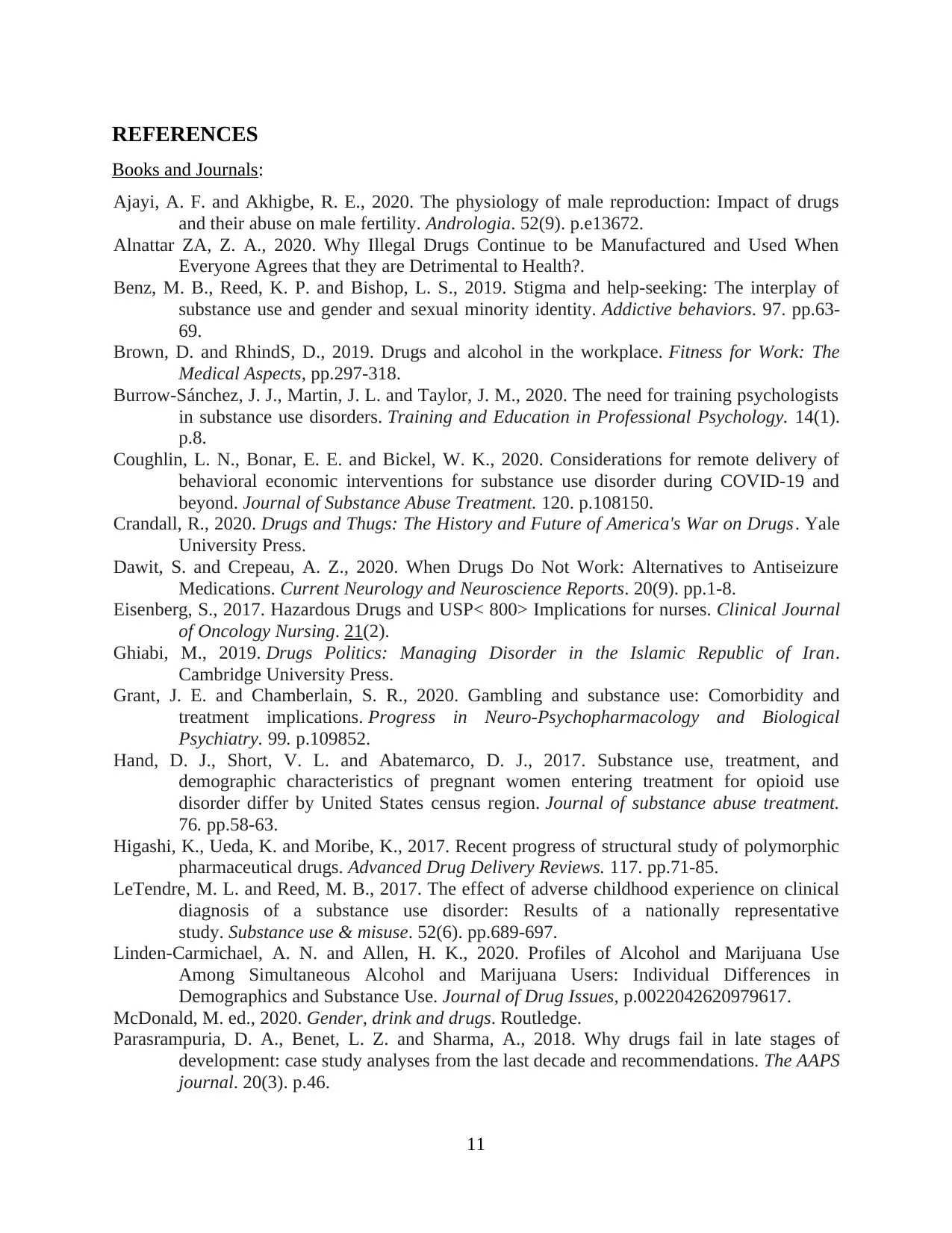
REFERENCES
Books and Journals:
Ajayi, A. F. and Akhigbe, R. E., 2020. The physiology of male reproduction: Impact of drugs
and their abuse on male fertility. Andrologia. 52(9). p.e13672.
Alnattar ZA, Z. A., 2020. Why Illegal Drugs Continue to be Manufactured and Used When
Everyone Agrees that they are Detrimental to Health?.
Benz, M. B., Reed, K. P. and Bishop, L. S., 2019. Stigma and help-seeking: The interplay of
substance use and gender and sexual minority identity. Addictive behaviors. 97. pp.63-
69.
Brown, D. and RhindS, D., 2019. Drugs and alcohol in the workplace. Fitness for Work: The
Medical Aspects, pp.297-318.
Burrow-Sánchez, J. J., Martin, J. L. and Taylor, J. M., 2020. The need for training psychologists
in substance use disorders. Training and Education in Professional Psychology. 14(1).
p.8.
Coughlin, L. N., Bonar, E. E. and Bickel, W. K., 2020. Considerations for remote delivery of
behavioral economic interventions for substance use disorder during COVID-19 and
beyond. Journal of Substance Abuse Treatment. 120. p.108150.
Crandall, R., 2020. Drugs and Thugs: The History and Future of America's War on Drugs. Yale
University Press.
Dawit, S. and Crepeau, A. Z., 2020. When Drugs Do Not Work: Alternatives to Antiseizure
Medications. Current Neurology and Neuroscience Reports. 20(9). pp.1-8.
Eisenberg, S., 2017. Hazardous Drugs and USP< 800> Implications for nurses. Clinical Journal
of Oncology Nursing. 21(2).
Ghiabi, M., 2019. Drugs Politics: Managing Disorder in the Islamic Republic of Iran.
Cambridge University Press.
Grant, J. E. and Chamberlain, S. R., 2020. Gambling and substance use: Comorbidity and
treatment implications. Progress in Neuro-Psychopharmacology and Biological
Psychiatry. 99. p.109852.
Hand, D. J., Short, V. L. and Abatemarco, D. J., 2017. Substance use, treatment, and
demographic characteristics of pregnant women entering treatment for opioid use
disorder differ by United States census region. Journal of substance abuse treatment.
76. pp.58-63.
Higashi, K., Ueda, K. and Moribe, K., 2017. Recent progress of structural study of polymorphic
pharmaceutical drugs. Advanced Drug Delivery Reviews. 117. pp.71-85.
LeTendre, M. L. and Reed, M. B., 2017. The effect of adverse childhood experience on clinical
diagnosis of a substance use disorder: Results of a nationally representative
study. Substance use & misuse. 52(6). pp.689-697.
Linden-Carmichael, A. N. and Allen, H. K., 2020. Profiles of Alcohol and Marijuana Use
Among Simultaneous Alcohol and Marijuana Users: Individual Differences in
Demographics and Substance Use. Journal of Drug Issues, p.0022042620979617.
McDonald, M. ed., 2020. Gender, drink and drugs. Routledge.
Parasrampuria, D. A., Benet, L. Z. and Sharma, A., 2018. Why drugs fail in late stages of
development: case study analyses from the last decade and recommendations. The AAPS
journal. 20(3). p.46.
11
Books and Journals:
Ajayi, A. F. and Akhigbe, R. E., 2020. The physiology of male reproduction: Impact of drugs
and their abuse on male fertility. Andrologia. 52(9). p.e13672.
Alnattar ZA, Z. A., 2020. Why Illegal Drugs Continue to be Manufactured and Used When
Everyone Agrees that they are Detrimental to Health?.
Benz, M. B., Reed, K. P. and Bishop, L. S., 2019. Stigma and help-seeking: The interplay of
substance use and gender and sexual minority identity. Addictive behaviors. 97. pp.63-
69.
Brown, D. and RhindS, D., 2019. Drugs and alcohol in the workplace. Fitness for Work: The
Medical Aspects, pp.297-318.
Burrow-Sánchez, J. J., Martin, J. L. and Taylor, J. M., 2020. The need for training psychologists
in substance use disorders. Training and Education in Professional Psychology. 14(1).
p.8.
Coughlin, L. N., Bonar, E. E. and Bickel, W. K., 2020. Considerations for remote delivery of
behavioral economic interventions for substance use disorder during COVID-19 and
beyond. Journal of Substance Abuse Treatment. 120. p.108150.
Crandall, R., 2020. Drugs and Thugs: The History and Future of America's War on Drugs. Yale
University Press.
Dawit, S. and Crepeau, A. Z., 2020. When Drugs Do Not Work: Alternatives to Antiseizure
Medications. Current Neurology and Neuroscience Reports. 20(9). pp.1-8.
Eisenberg, S., 2017. Hazardous Drugs and USP< 800> Implications for nurses. Clinical Journal
of Oncology Nursing. 21(2).
Ghiabi, M., 2019. Drugs Politics: Managing Disorder in the Islamic Republic of Iran.
Cambridge University Press.
Grant, J. E. and Chamberlain, S. R., 2020. Gambling and substance use: Comorbidity and
treatment implications. Progress in Neuro-Psychopharmacology and Biological
Psychiatry. 99. p.109852.
Hand, D. J., Short, V. L. and Abatemarco, D. J., 2017. Substance use, treatment, and
demographic characteristics of pregnant women entering treatment for opioid use
disorder differ by United States census region. Journal of substance abuse treatment.
76. pp.58-63.
Higashi, K., Ueda, K. and Moribe, K., 2017. Recent progress of structural study of polymorphic
pharmaceutical drugs. Advanced Drug Delivery Reviews. 117. pp.71-85.
LeTendre, M. L. and Reed, M. B., 2017. The effect of adverse childhood experience on clinical
diagnosis of a substance use disorder: Results of a nationally representative
study. Substance use & misuse. 52(6). pp.689-697.
Linden-Carmichael, A. N. and Allen, H. K., 2020. Profiles of Alcohol and Marijuana Use
Among Simultaneous Alcohol and Marijuana Users: Individual Differences in
Demographics and Substance Use. Journal of Drug Issues, p.0022042620979617.
McDonald, M. ed., 2020. Gender, drink and drugs. Routledge.
Parasrampuria, D. A., Benet, L. Z. and Sharma, A., 2018. Why drugs fail in late stages of
development: case study analyses from the last decade and recommendations. The AAPS
journal. 20(3). p.46.
11
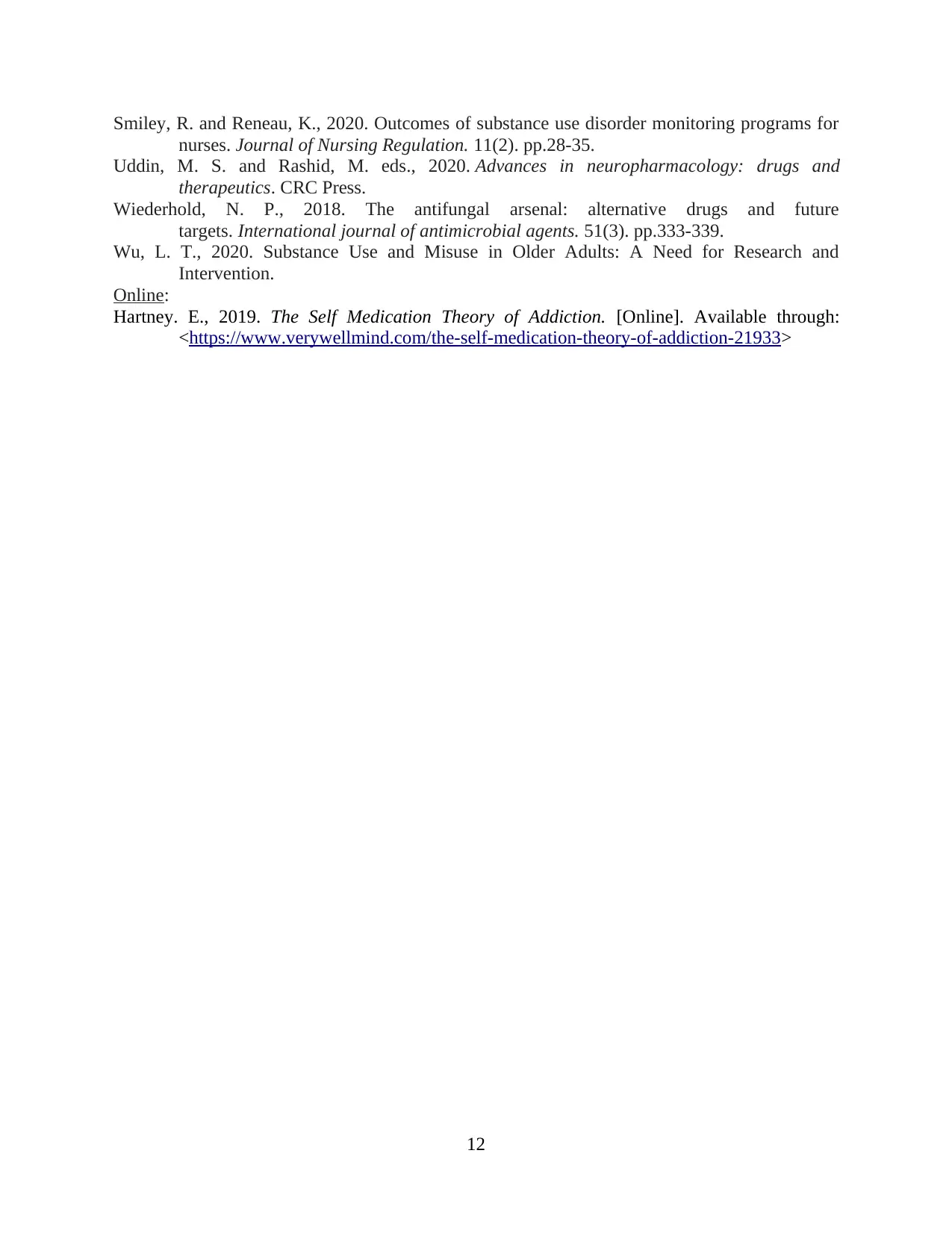
Smiley, R. and Reneau, K., 2020. Outcomes of substance use disorder monitoring programs for
nurses. Journal of Nursing Regulation. 11(2). pp.28-35.
Uddin, M. S. and Rashid, M. eds., 2020. Advances in neuropharmacology: drugs and
therapeutics. CRC Press.
Wiederhold, N. P., 2018. The antifungal arsenal: alternative drugs and future
targets. International journal of antimicrobial agents. 51(3). pp.333-339.
Wu, L. T., 2020. Substance Use and Misuse in Older Adults: A Need for Research and
Intervention.
Online:
Hartney. E., 2019. The Self Medication Theory of Addiction. [Online]. Available through:
<https://www.verywellmind.com/the-self-medication-theory-of-addiction-21933>
12
nurses. Journal of Nursing Regulation. 11(2). pp.28-35.
Uddin, M. S. and Rashid, M. eds., 2020. Advances in neuropharmacology: drugs and
therapeutics. CRC Press.
Wiederhold, N. P., 2018. The antifungal arsenal: alternative drugs and future
targets. International journal of antimicrobial agents. 51(3). pp.333-339.
Wu, L. T., 2020. Substance Use and Misuse in Older Adults: A Need for Research and
Intervention.
Online:
Hartney. E., 2019. The Self Medication Theory of Addiction. [Online]. Available through:
<https://www.verywellmind.com/the-self-medication-theory-of-addiction-21933>
12
1 out of 15
Your All-in-One AI-Powered Toolkit for Academic Success.
+13062052269
info@desklib.com
Available 24*7 on WhatsApp / Email
![[object Object]](/_next/static/media/star-bottom.7253800d.svg)
Unlock your academic potential
© 2024 | Zucol Services PVT LTD | All rights reserved.

